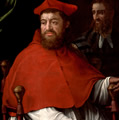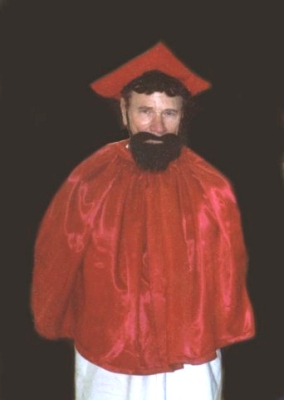CARDINAL GIOVANNI SALVIATI
Sebastiano del Piombo
Italian, 1485-1547
SN 65, oil on panelFrom "The Pages" |
 |
ARTIST:
Born as Sebastiano Luciano into an upper-middle-class family; his father was a velvet
maker. Sebastiano was much admired for his poetry, and expertise on the lute. He began
training as a painter at a relatively mature age (18-20?), first under Giovanni Bellini,
then Giorgione. Influenced by both, he nevertheless had great freedom & capacity for
technical and iconographic innovation. He painted masterfully colorful frescoes,
altarpieces, & portraits.
In Rome he worked closely with Michelangelo, with whom he formed a life-long friendship.
The latter on occasion would provide Sebastiano with sketches; however, as Sebastiano was
an excellent draftsman himself, he most often did his own thing.
According to Vasari, Cardinal Giulio de Medici decided to offer competitive commissions:
Sebastiano was to paint an altarpiece on the raising of Lazarus; at the same time, Raphael
was to do the Transfiguration. Both paintings were to be sent to the Cathedral in
Narbonne. |
|

Docent Anderson as Cardinal Salviati
|
With some help from his friend Michelangelo, Sebastiano finished first, & his
painting was an immediate success. In April, 1520, both paintings we reexhibited. However,
Raphael was spared comparison as he died a few days before the exhibit. Sebastiano’s
Lazanus went to Narbonne, Raphael’s transfiguration remained in Rome.
After his death, Piombo was considered the best artist in Rome. In 1531, in recognition of
his great works, the Pope made him Keeper of the Papal Seals. This required him to be a
friar, hence the name Fra Sebastiano del Piombo. He died in Rome in 1547.
SUBJECT:
This is a double portrait: Cardinal Giovanni Salviati and his secretary (seen to his left,
in the background).
Edward Lorany restored the painting in 1959, revealing the second figure.
The Cardinal, wearing a red hat, is seated in a wooden chair. His massive figure is
clothed in a white robe with short red cape. His expression is stony, his gaze directed
away from the viewer.
At the time of Ringling’s purchase of this work, the sitter was identified as
Cardinal William Enckenvoert (1464-1534). And Piombo did indeed paint Enckenvoert’s
portrait at a later date. But the identification of our painting was corrected when, in a
private collection, an identical figure was seen inscribed as “Ioannes Salviatus,
Card.”
Giovanni Salviati was born in 1490, a Medici on his mother’s side, a grandson of
Lorenzo Il Magnifico, and a nephew of Pope Leo X - who made him a Cardinal in 1517. He was
legate to Francis in N.Italy in 1524, then sent to Spain on a peace mission. In 1527 he
accompanied Francis to Paris, remaining there for 7 years.
PAINTING:
Sebastiano’s stylistic development, and his relationship to Michelangelo, suggests a
date 1530-32 for this work.
The device of using main & secondary figures is a favorite of the artist, which was
appreciated by Raphael. The addition of the 2nd figure produces a classical and harmonious
symmetry. The style is Mannerist – note the abrupt turn of the head, its transition
concealed behind the red cape and gray beard; there is tension, reinforced by the emphatic
right-hand gesture – possibly an impact of Michelangelo.
Additional Bibliography:
Palluchini, Rodolfo “Sebastiano Viniziano.” Casa Editrice Mondadori, 1944, pp
63-64.
Creighton, Gilbert “A New Work by Sebastiano del Piombo and an Offer by
Michelangelo.” A
Sarasota Notebook, Arte Veneta, 1961, pp 38-9.
Freedberg, JS “Paintings in Italy 1500-1600.” 1971, pp 67, 148-153.
Hurtubise, OMI, Pierre “Une Famille T moin Les Salviati.” Citta del Vaticano
Biblioteca Apostolica
Vaticano,1985, pp 234-266.
Vasari, Giorgio “Lives of the Painters, Sculptors, and Architects.” Translated
by Gaston de Vere.
1996, Vol 2, pp140-152.
ringlingdocents.org
|

